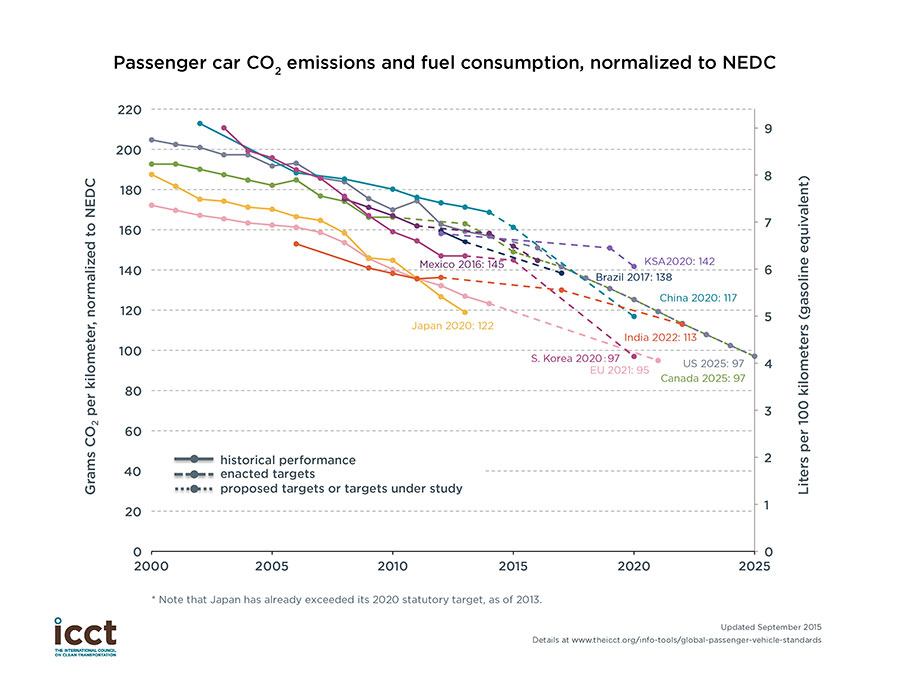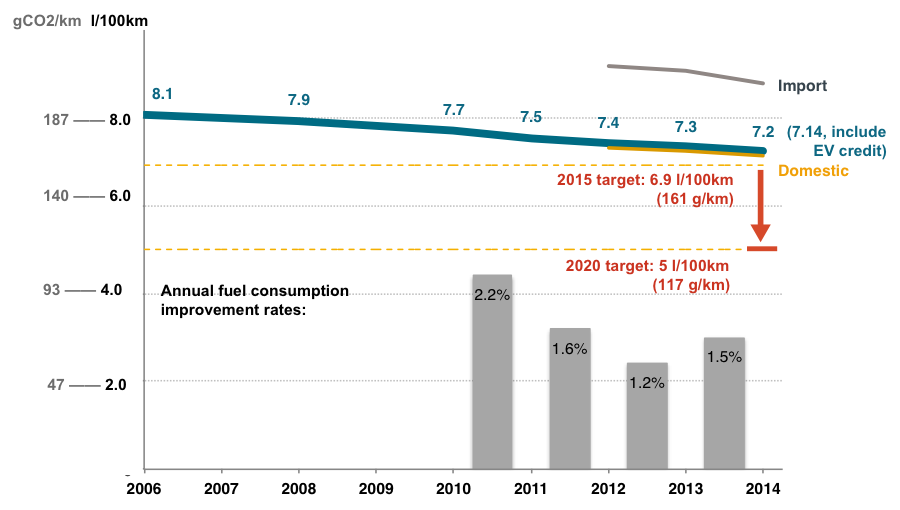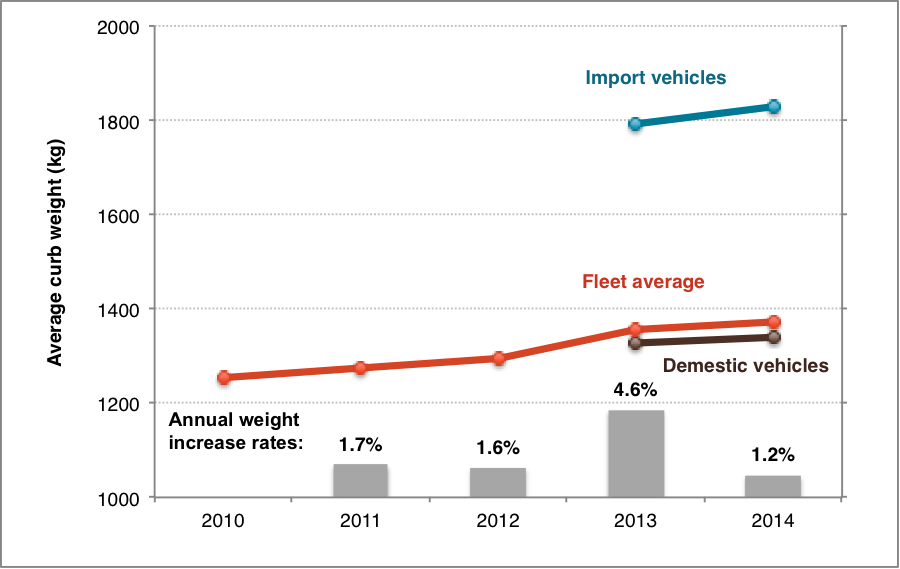China Phase 3 new passenger car fuel consumption: Proposed implementation rule
Blog
China still lagging on fuel consumption in 2014
Following the timeline determined in the Corporate Average Fuel Consumption (CAFC) accounting rule, China’s Ministry of Industry and Information Technology (MIIT) released its 2014 CAFC report in June 2015. One of the highlights is China’s new passenger car production for domestic sales and imports, which combined reached 20.3 million units from 116 manufacturers, an 11.4% increase over 2013. The reported average fuel consumption for these new passenger vehicles (excluding electric vehicles) is 7.22 L/100km (7.12 L/100km for domestic manufactured vehicles and 8.76 L/100km for import vehicles). Compared to the 2013 average fuel consumption of 7.33 L/100km, the 2014 value is lower by 1.5%. This may seem like good news. But in fact, it means that, among the countries that have a passenger vehicle efficiency standard, China remains the least efficient (see figure below).

China’s overall fleet fuel consumption has decreased slowly in recent years, by 1.6% annually on average. Average fuel consumption of import vehicles has dropped more quickly than domestic vehicles, but this does not have a big impact on the overall fleet average, as imports account for only 6% of total sales (see figure below). In 2007 China’s passenger car fleet average fuel consumption was similar to that of the US, Canada, and Mexico. However, these countries fleets are becoming more efficient at a faster rate than China’s, which is causing China to fall behind. Even Australia is making progress more rapidly than China, and may soon catch up, despite having no fuel economy regulation in place. If the present trend continues, China will miss its national goal of 6.9 L/100km in 2015 (a 3.9% fuel consumption reduction is needed from 2014 to meet the target).

(Note: The 2012 fuel consumptions of import and domestic fleet separately show the fleet average fuel consumption for the second half of 2012.)
One reason China’s fleet average fuel consumption has improved so slowly is that its vehicle fleet is getting heavier. In recent years, Chinese consumers have opted to buy heavier and larger cars, causing the average curb weight of the fleet to increase consistently since 2010 (see figure below).

The growth of sports utility vehicle (SUV)/multi-purpose vehicle (MPV) sales is another contributing factor. As the table below shows, between 2009 and 2014, sales shares of SUVs and MPVs increased from 11% to 33%. SUVs/MPVs are subject to a less stringent standard compared to the rest of the fleet, so they not only increase the average weight of the fleet, but also loosen the manufacturers’ fleet average target.

Data source: Marklines
A manufacturers’ CAFC target is indexed to the average curb mass of the vehicles it produces; therefore, if the average mass of its production fleet increases, its fuel consumption target gets less stringent. The 6.9 L/100km fleet-wide target for 2015 was based on an assumed overall fleet-average curb mass of around 1280 kg, far below the 2014 average curb mass of 1371 kg. That’s why even though individual manufacturers are making good progress, the fleet as a whole is falling behind the national target of 6.9 L/100km.
As detailed in a number of ICCT papers (for example, here), the rapid increase of fleet average curb weight is a consequence of regulatory design. One possible solution is to establish a unified standard curve for all types of passenger cars and have a flat, continuous fleet target that minimizes manufacturers’ incentive to build heavier vehicles. A continuous weight-based standard curve, such as is used in the EU, can maintain the stringency of the standard for a heavier fleet of vehicles. Switching to a size-based standard, as the US has done, is a better solution, because the size of the vehicle does not increase as easily as weight. A size-based standard is more technology-neutral than a weight-based standard, and therefore reduces manufacturer compliance costs in meeting more stringent long-term targets.
China’s 2020 goal of 5 L/100km would put it among those countries leading the charge on fuel efficiency standards. But its weight-based standards, coupled with recent consumer trends, could make it difficult to reach this goal even if all manufacturers meet their standards.
According to MIIT, multipliers for new energy vehicles (NEVs) will be included in the fleet average calculation beginning in 2016. The calculation will count each battery electric vehicle (BEV) with a battery range greater than 50 km five times at 0 L/km (decreasing to two times in 2020), bringing the manufacturer’s fleet average down further. Plug-in hybrid electric vehicles (PHEVs) with fuel consumption lower than 2.8 L/100km will be counted three times (decreasing to 1.5 times in 2020). An accelerated expansion of the electric vehicle market (and EV sales in the first half of 2015 almost equal total annual sales in 2014) may help China achieve 0.1-0.15 L/100km more in complying with the 2016–2020 standards.
With the increase in fleet average weight, it is unlikely that China will meet the 6.9 L/100km national target in 2015, even if all individual manufacturers meet their weight-based standards. Beginning in 2016, EV multipliers in the compliance accounting may alleviate the short-term compliance pressure on manufacturers, but the real question is: how long will this last? Will a heavier fleet impede China’s effort to reduce real-world GHG emissions from vehicles? It will be interesting to see the path that China takes in pursuit of its fleet average target for later years.
